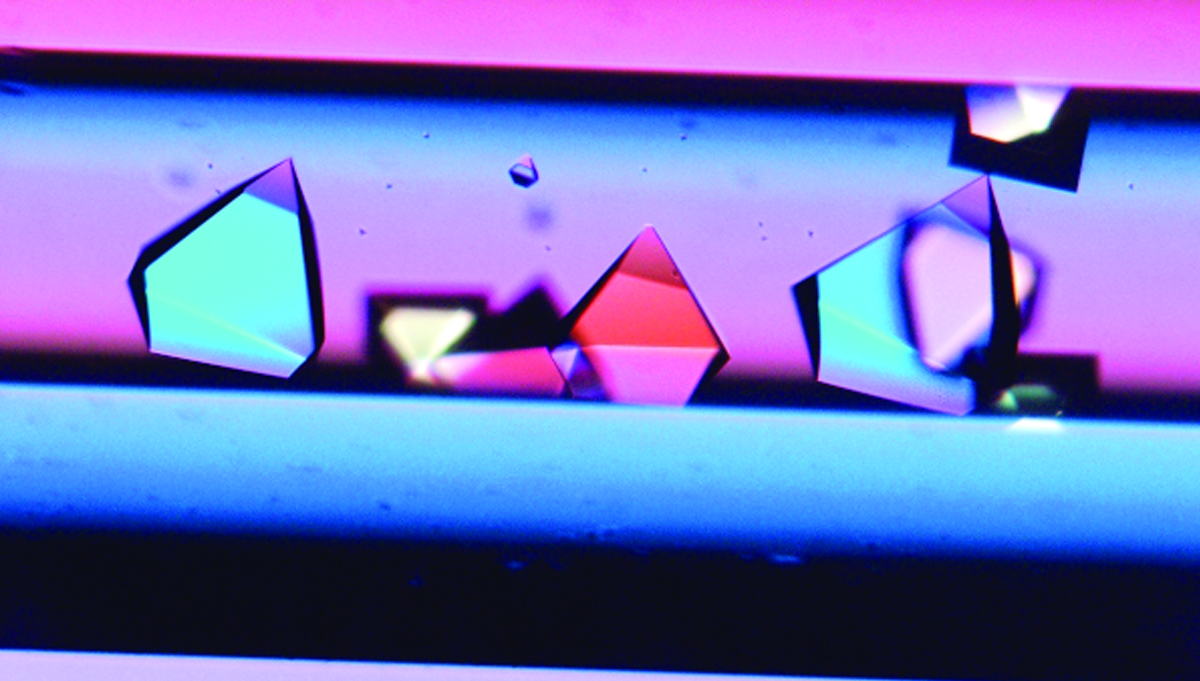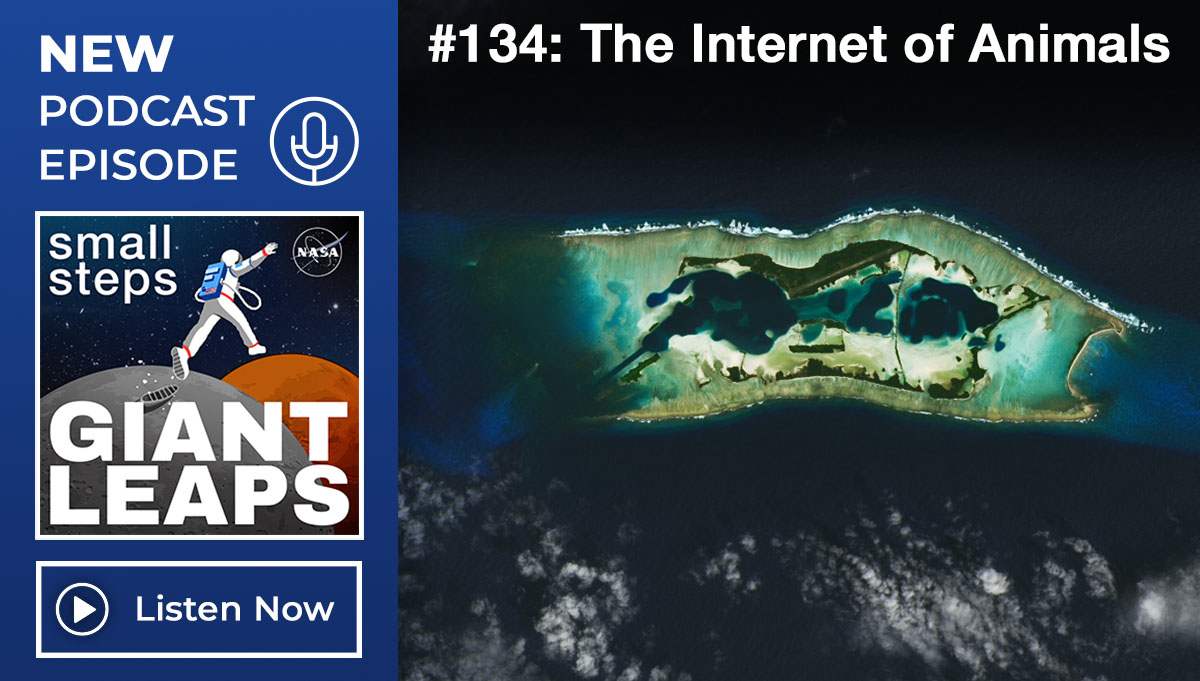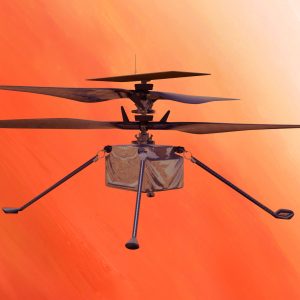Ingenuity Mars Helicopter Chief Pilot Håvard Grip discusses the rotorcraft’s history-making flights on the Red Planet.
The Ingenuity Mars Helicopter, a technology demonstration to test powered, controlled flight on another world, successfully completed its first experimental flight on Mars in April 2021. Following four more flights, NASA transitioned Ingenuity into an operations demonstration phase, testing its ability to provide an aerial dimension to the Perseverance rover mission, and recently extended Ingenuity flight operations through September 2022.
The helicopter was built by NASA’s Jet Propulsion Laboratory, which also manages the technology demonstration project for NASA Headquarters. The project is supported by NASA’s Science Mission Directorate. NASA’s Ames Research Center and Langley Research Center provided significant flight performance analysis and technical assistance during Ingenuity’s development.
In this episode of Small Steps, Giant Leaps, you’ll learn about:
- Experiences and responsibilities of a Martian helicopter pilot
- Ingenuity science and exploration achievements
- Future possibilities for helicopters on Mars
Related Resources
Mars Helicopter Status Updates
First Video of NASA’s Ingenuity Mars Helicopter in Flight
NASA Extends Ingenuity Helicopter Mission
Episode 53: Ingenuity Mars Helicopter (Small Steps, Giant Leaps)
APPEL Courses:
Leading Complex Projects (APPEL-vLCP)
Risk Management I (APPEL-vRM I)
Lifecycle, Processes & Systems Engineering (APPEL-vLPSE)
Requirements Development and Management (APPEL-vREQ)

Håvard Grip
Credit: NASA
Håvard Grip is the Ingenuity Mars Helicopter Chief Pilot, responsible for the planning and analysis of Ingenuity’s flights on Mars. Grip joined the Ingenuity team in 2013 and led the development of Ingenuity’s Flight Control system. He built the dynamic models and simulation software used for Ingenuity’s development and led the design and implementation of the helicopter’s guidance, navigation, and control algorithms. Prior to joining NASA’s Jet Propulsion Laboratory, Grip performed research and development work at the SINTEF Research Group in Trondheim, Norway; Daimler AG in Stuttgart, Germany; and Washington State University in Pullman, Washington. He received his master’s and doctorate in engineering cybernetics from the Norwegian University of Science and Technology.
Transcript
Håvard Grip: We hope that this is the start of a new era of aviation in space.
The technology is there now. It’s possible not only to land on Mars, not only to drive around on Mars, but to fly around on Mars.
We’ve done things with the helicopter that we not only didn’t plan for, we didn’t really dream about the kinds of flights that we’ve been able to take with it.
Deana Nunley (Host): Welcome to Small Steps, Giant Leaps, a NASA APPEL Knowledge Services podcast where we tap into project experiences to share best practices, lessons learned and novel ideas.
I’m Deana Nunley.
The Mars helicopter, Ingenuity, made history as the first aircraft to achieve powered, controlled flight in the extremely thin atmosphere of Mars and the first such flight in any world beyond Earth.
The small, autonomous helicopter rode to the Red Planet attached to the belly of the Perseverance rover, which landed in February 2021.
Today on the podcast we’re chatting with the pioneering rotorcraft’s Chief Pilot, Håvard Grip.
Håvard, thanks so much for joining us.
Grip: Thank you for having me.
Host: Ingenuity Mars Helicopter Chief Pilot sounds like one of the coolest jobs in the universe. Is it as cool as it sounds?
Grip: Yeah. To me, it is pretty much the coolest job that I could imagine having. I feel like an explorer sitting here on Earth, commanding a helicopter on another planet and making stuff happen several hundred million miles away. And then getting images back from previously unexplored areas, images that have never been seen before of areas that have stood untouched for millions of years. It is enough to give me goosebumps on an almost daily basis.
Host: I can only imagine. What exactly do you do?
Grip: So, my main job and the job of my team is to plan each flight that’s going to happen on Mars in detail. Ingenuity, when it wakes up in the morning, it doesn’t know what to do, where to fly or even where it is at that moment. What it knows is to get on the radio and listen for commands. And it’s our job to give it the right kinds of commands. So that means partly thinking strategically ahead. What are we trying to accomplish? Where do we want to go? And how can we do that? A big part of that is, where can we land? It’s not obvious on Mars where is a good place to land for a helicopter, especially one that doesn’t have the ability itself to distinguish between somewhere that’s land-able and not.
And then we have to get down to the nitty gritty of each flight, designing each maneuver that the helicopter is going to take, the precise timing of those maneuvers and the precise parameters of those maneuvers. And ultimately then we come up with a sequence of commands that gets uplinked to the helicopter. And then it’s up to the helicopter at that point to try to do what we’ve asked it to do to the best of its ability. And a big part of the job after that is to assess just how well did it go? We have to look at that data and assess, in terms of aerodynamics, in terms of flight controls, how well did it go? Are there any concerns, things we need to do differently? Or maybe we can push it even further in the next flight.
Host: I’m curious. How did you prepare to do this job?
Grip: So, during the development of Ingenuity, my job was to lead the aerodynamics and the flight control development for Ingenuity. So that meant getting to really know at an intimate level, just how the helicopter works and how it handles in this very unusual environment that Mars represents. It also meant living with the helicopter for extended periods of time in what we call the JPL 25-Foot Space Simulator, which is a facility that we have at JPL. It’s a big vacuum chamber where we can replicate the Martian atmospheric conditions. And so we used that facility for extended periods of time to do aerodynamics and flight control experiments and do actual flights eventually in that environment. And all of that experience we carry with us into operations on Mars.
Host: What was your experience prior to that?
Grip: My experience is fairly diverse in a sense of having worked with cars and boats and airplanes, not actually helicopters until I got to that, but I have that research background, and also a personal interest, in fact, in aviation. And I have a private pilot’s license and used to own my own little fixed-wing airplane. And so I had that interest too, that I think helps make it a natural thing for me to get into this.
Host: The helicopter’s performance on Mars has been amazing. Has it exceeded your expectations?
Grip: Ingenuity has massively exceeded expectations. And to see that all you have to do is to look at the statistics. We were supposed to have a one-month mission on the surface and fly up to five times. And now we have survived almost 15 months and we’ve flown 29 times to this point. And so that is just massively exceeding those expectations. And we’ve done things with the helicopter that we not only didn’t plan for, we didn’t really dream about the kinds of flights that we’ve been able to take with it.
Host: Let’s go back to April 19, 2021. You’re piloting the first aircraft in history to make a powered, controlled flight on another planet. How thrilling was that?
Grip: That first flight, it was extremely thrilling. And at the same time, it was a moment of really high tension and ultimately a lot of relief. We had come so far to that point designing and building this helicopter, putting it on a rocket and sending it to Mars and landing there, finding a good place to put it down. And we were talking to it. We had checked out everything. Things were working. It was ready to fly, but then it actually had to do that job. And so, on the one hand, if that worked, it would be the glorious, crowning achievement to this project. Or on the other hand, it’s like you could almost literally crash and burn in front of a huge live audience. And so there was a lot of tension around that and when it worked as well as it did, just really relieving and just seeing all of that work come to fruition.
Host: What are some of your favorite moments and memories so far in your experience as a Martian helicopter pilot?
Grip: So, there are a couple of flights that stand out for me. And one is of course, that first flight, because it was the first time in history that an aircraft had flown in a controlled way outside of our own atmosphere. So that was an obvious favorite.
And then the other flight that stands out for me is flight number nine, because it was a breakout moment for the helicopter. It was right after we’d started our extended operations. And we were trying to keep up with Perseverance and feeling our way, doing these flights that were 100 meters, 200 meters at a time, that order magnitude.
And then in Flight Nine, we decided to take this huge risk. Instead of following Perseverance around this area called ‘Séítah,’ which has much greater terrain variation than we’d seen to that point, sand dunes and ripples and boulders and craters. Instead of following Perseverance around that terrain, we decided to do what only a helicopter could do and that’s fly straight across it, more than 600 meters in a single flight. And it was a huge risk to take. And we knew that, but the rewards were so great that we decided that that was the right call to make. And then it worked. And that set the stage for us to be able to do some really amazing things, because now we were far ahead of the rover on its trajectory, and we were able to go out ahead of it and scout these really interesting targets. And I think that really set the level of expectations for the rest of the mission.
Host: That is so cool. In terms of science and exploration, what are some of the biggest achievements of the helicopter?
Grip: The biggest achievement I think is just showing the potential that’s inherent in this kind of technology, what the helicopter can do. But even beyond that, in this very mission, we’ve been able to accomplish things to benefit in an exploration and science sense. Probably the biggest things there was in an area called ‘Séítah South,’ where after this Flight Nine that I spoke about, we went out there ahead of the rover and were able to take images that directly fed back to the rover drivers and the scientists on the team, to help them see what they were going to find ahead, to plan that in detail on their end. And I think that was a big achievement for the helicopter.
Host: And a month or so ago, one of the helicopter’s navigation sensors stopped functioning. Could you walk us through what happened and how the team responded?
Grip: Yeah, so we are right now in the challenging season for the helicopter. We’re going into winter and we have a shortage of energy that means that we are no longer able to keep ourselves warm during the nights, the way that we designed for originally. So that means that the temperature at night, it drops down to about minus 80 degrees Celsius. And we’ve been able to survive this and wake up again each morning, but one of our sensors has given out and it’s a sensor called the inclinometer. An inclinometer is used only prior to each flight in order to determine the roll and pitch before flight. And by doing that, we can also calibrate out most of the bias in our onboard accelerometers before we start flying.
The inclinometer is not working anymore. Now, in fact, the benefit that we had is we had actually thought about this particular scenario before we even got to Mars. We were ticking through all of the potential faults that we could encounter, and one of those was, ‘Well, what if we get to Mars and we don’t have a functioning inclinometer?’ And we were able to come up with a way to work around that, that basically meant having the accelerometers stand in for the inclinometer. And it’s not as accurate as it otherwise would be. And so there is some additional risk associated with that. However, we determined, especially now with the benefit of having flown for over a year, that this was very likely to work. And so we had a software update on its way to Mars, within just a few days of discovering this fault. And in fact, now we have flown successfully with that software update.
Host: What other challenges has Ingenuity faced since landing on Mars?
Grip: There’s almost every week, there is some new little thing that comes up. A lot of it has to do with environment. We have survived of course, far beyond the intended mission duration. And so the environment keeps changing with the seasons. One of them is what we’re facing right now, with the going into winter where the days are shorter. It gets colder during the daytime. And then the atmosphere is full of dust, which prevents energy or solar energy from landing on our solar panel. And that’s part of that causes us to not be able to keep ourselves warm during the night and also means we just have a lot less energy to use for flying during the day. And so that means we can basically not fly as long.
Earlier in the mission, we had challenges with density. In the summertime on Mars, density drops even lower than what it was when we arrived on Mars, and it dropped even below the level that we had designed Ingenuity for. So we actually had to spin the rotors faster for the first time on Mars than we’d ever done in testing here on Earth. So that was pretty exciting to try that out for the first time there.
And then we also had an anomaly pretty early on in the mission in Flight Six. We had an anomaly where the timestamps associated with the images that we received from the navigation camera at 30 times per second, those timestamps didn’t line up properly with the images. And so the navigation algorithms were interpreting the images in the wrong context, so to speak, and that caused some pretty dramatic oscillations in attitude and velocity of the helicopter, but thankfully we were able to land successfully and safely, and then address that with the subsequent software update.
Host: When you’re in a process like that, and you see that something’s not going exactly as planned, how quickly are you seeing that? How quickly can you react? What do you do?
Grip: So, when we send commands to Ingenuity, it is on its own during the entirety of the flight, just because of the light time between Mars and Earth. Even if we could communicate directly at the speed of light, still the time it would take for those signals to arrive here on Earth, it’s longer than the flight lasts. And so, we do our best to give it the safest possible commands here from Earth, to not command it to do something that would be unsafe. But then we have to cross our fingers and we only get to learn after the fact about how that went down.
So, with the Flight Number Six, where we had this anomaly, we got the data a few hours after it happened. But once we looked at it, it was immediately obvious that something had not gone according to plan. And in fact it was fairly obvious right away what had happened, and within just a couple of hours, we’d actually diagnosed the problem here on the ground and began working on a fix.
Host: And so that fix goes into effect whenever you fly the next time, which could be what — days later, weeks later?
Grip: Yeah. So, we were talking here, at that phase of the mission, we were flying roughly once every two weeks. So, the first thing we did, we identified a root cause so we were able to avoid with our commanding for the next few flights, while we prepared a software update. And that came a little bit later where we could apply that software update. That’s a pretty big deal to apply a software update on Mars. It’s just like applying software update on Earth, but if something goes wrong in the process, it’s not like you can walk over and pull the power cord or push a button. So you have to be really careful with those. And so that came a little bit later, but that restored ourselves, so to speak, to full functionality again, without encountering this particular issue.
Host: So, in both the development and the operational phases, are there lessons learned that might be helpful to other NASA technical workers?
Grip: Yeah. So, when we’re talking about lessons learned, one thing that comes to mind is something that our project manager, MiMi Aung used to say during development, which is in this project, you’re all systems engineers. And what that meant is nobody could really silo themselves, roll themselves off and just focus on their area without thinking through how that connected in with all of the other areas of the system. You couldn’t stop worrying about the system-level ramifications. And I think that was really important, for everyone to think across subsystem boundaries in that way. I think it helped us worry about the right things and cover a lot of things that we might not otherwise have thought about. And so I’d say that that’s something that I try to take with me in other contexts as well.
Host: NASA announced a few months ago that it’s extending the Ingenuity mission through September. What’s planned between now and September?
Grip: So right now, we are in this challenging season, early winter, with a lot of dust in the atmosphere and we’re low on energy. And part of the implications of that is we can’t fly the same kinds of flights that we’ve done earlier in the mission. And so over the next few months, a lot of what we’re going to do is first of all, wait for that season, to get through that season, where the conditions are more favorable for flying. And in the process, while we’re doing that, we’re also going to be focusing on some software updates to enhance the capabilities of Ingenuity. We want to give it capabilities that will allow it to more safely traverse complex terrain and avoid obstacles on landing. So we’re going to be focusing on that and hopefully equipping Ingenuity with those capabilities, so it can keep flying for even longer.
Host: How do you envision helicopters being used on Mars in the future?
Grip: Well, now we’re at the point where it’s up to just people’s imagination. The technology is there now. It’s possible not only to land on Mars, not only to drive around on Mars, but to fly around on Mars. And so now it’s a challenge that we can put to the scientists to spend their days thinking about Mars. How can you leverage this technology? You can fly around and do reconnaissance, as Ingenuity has been done. You can take other sensors, other scientific equipment. You could move things, pick things up. It’s really just a matter of how well you use your imagination. And so I’m really excited to see what comes next.
Host: And I think we all are. Håvard, this has been incredibly fascinating. Thank you so much for taking time to talk with us.
Grip: Thank you so much for having me on.
Host: Do you have any closing thoughts?
Grip: It’s just really exciting to see what the future holds. We’ve already started working on how can we make helicopters larger, faster, more capable, in order to realize the full potential that’s ahead. And so we hope that this is the start of a new era of aviation in space. And so we’re really excited about that.
Host: You’ll find Håvard’s bio, links to topics discussed during our conversation, and a transcript of today’s show at APPEL.NASA.gov/podcast.
If you like the podcast, please follow us on your favorite podcast app and share the episode with your friends and colleagues.
As always, thanks for listening to Small Steps, Giant Leaps.







